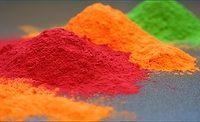Master the Art of Custom Powder Coating Colors

Custom powder coat colors appeal to customers by allowing them to create desired hues that personalize their furniture, building accents, cars or other items. What should professionals know to get the best results with their colorful creations?
What Methods Do People Use to Make Custom Powder Coat Colors?
Creating custom powder coat colors differs from the processes people use to customize liquid paint hues. The main reason is that powder coating products contain only solid particles. Mixing solid or liquid pigments into liquid coatings results in an intermediate color, however when mixing solid pigments into powder coatings it results in a speckled, blended effect.
One popular customization technique is to blend a pre-made powder coating with metallic or pearlescent flakes. This approach causes a shimmering effect that’s quite striking. Some options also give a color-shifting effect, so the appearance looks different depending on the viewing angle.
Alternatively, clients can bring swatches of desired colors to powder coat shops, where workers will use special scanners and apps to analyze the hues. They then add pigments to powder coating products to get the customers’ required results. This approach can be costly for people who only need the colors in small batches, as paint shops usually require minimum amounts.
Code matching is another possibility, especially since the Pantone Color Matching System has codes for thousands of hues. Instead of using scanners or making best estimates based on color perception, professionals can find the Pantone code that aligns with the powder coat shade.
Trial and error is the least exact method for getting custom colors, but clients may prefer it to meet non-time-sensitive needs. It involves experts combining at least two pigments to create small amounts of the identified hue and adding it to the powder coating. They test the results by applying the custom-colored coating to a surface similar to the client’s workpiece and curing it.
The final step is to inspect the outcome under various lighting to see how closely it matches the customer’s expectations. Paint shops only produce the color in larger quantities after client approval.
Creating Custom Colors for Particular Projects
Color customization needs vary depending on the item and why people want specific hues. Sometimes, customers’ powder coating requests reflect trends and the desire to embrace modern styles. Experts familiar with custom powder coating colors for automobiles have seen a rising demand for them, especially because car owners want shades that reflect their personalities.
Companies also provide custom colors for architectural needs. One business has 36 stock colors but relies on a supplier network for customization. Its aluminum extrusion subsidiary uses a vertical powder-coating system for quick changes and minimal production interruptions.
Powder coating uses no solvents (no liquid element) and produces less waste than alternatives. These advantages make it attractive to city planners or professionals aiming for environmentally friendly targets with their projects.
Interior designers also appreciate powder coating and love how they can customize colors to create carefully thought-out looks. A San Francisco-based venture capital firm moved to a 100-year-old Texas bungalow that served many purposes. Throughout the years, people have known it as a brothel, office building, and Airbnb property. It is now a three-story workspace with floor-to-ceiling windows.
Details such as the leather-wrapped reception desk and chandelier crafted by a local artist impress visitors and occupants. The aluminum fireplace also features a custom powder coating. This example shows how clients can consider the method for both indoor and outdoor projects.
One painter and design enthusiast has used vibrant powder coating colors throughout her home, resulting in pink faucets, blue kitchen chairs and a yellow light fixture. Powder coating suits all metal (and some wood) surfaces, and custom colors allow people to get creative and enjoy one-of-a-kind results.
Applying Technology When Working with Custom Powder Coat Colors
Professionals have also explored how technology can benefit them when making or applying custom colors. Such efforts are part of a larger trend that has disrupted the art world and other industries. Some people point out that technologies such as artificial intelligence enhance their workflows, providing more opportunities to enjoy creative pursuits.
One example of how that looks in a commercial setting comes from a South Korean chemical company that developed an AI-based color-matching system. Industry professionals can use the tool on computers or mobile devices to respond quickly to incoming orders.
Elsewhere, a paint manufacturer developed a tool that uses machine learning to create color palettes from voice prompts. It solves the persistent problem of people having clear ideas of desired hues, but not finding comparative examples. Users can start by describing memories or feelings and tweak the output until the palette features their envisioned shades.
These high-tech applications could significantly reduce the trial and error that can add time and costs to custom powder coat colors. Similarly, numerous commercially available augmented reality apps allow people to hold their phones or tablets up to areas of their room and find the best complementing or matching hues.
Automation has also improved the powder coatings industry, enabling companies to embrace data-driven operations that maintain consistency and reduce waste. Specialized machines can accelerate color changes, making them time savers for projects requiring different hues on various work piece parts. One automated product can switch between colors in less than 20 seconds when used on non-reclaim systems.
Getting the Best Results
A final aspect of excelling in the art of custom powder coat colors involves having in-depth conversations with clients to understand their needs and set accurate expectations. Polyester powder coatings are excellent for outdoor applications since they resist fading from ultraviolet exposure. In contrast, although epoxy powder coatings withstand chemical corrosion, they lack ultraviolet protection.
Clients will also have preferences regarding whether they prefer glossy or matte finishes. Experts should consider showing them examples of all possibilities so they can make confident decisions. They can discuss how high-gloss coatings are easy to clean, but imperfections are more evident on surfaces with those than matte options.
Customers should understand that lighting can result in drastic color-appearance differences. Suppose someone chooses their hue in a paint shop but wants it for an item that will be placed in a sun-drenched outdoor area. The client may be disappointed with the outcome.
Customers should take a custom color swatch to the place that will feature the powder-coated surface. If they dislike what they see, they should provide as many specifics as possible about what to change with future attempts.
Besides having ongoing communications with clients throughout their projects, experts should emphasize skill development by staying updated about new technologies, processes and tools. Knowledge of what is new in the industry could become a significant selling point that attracts and retains customers or prompts them to recommend the company to people they know.
Looking for a reprint of this article?
From high-res PDFs to custom plaques, order your copy today!





